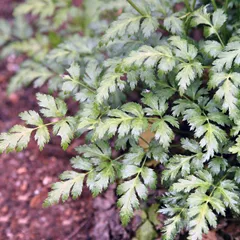Damp-Heat in Stomach and Spleen
The information provided here is not a replacement for a doctor. You shouldn't use it for the purpose of self-diagnosing or self-medicating but rather so you can have a more informed discussion with a professional TCM practitioner.
At a glance
Preliminary reading: What is a pattern? The concept of Dampness The concept of Heat The Stomach in Chinese Medicine The Spleen in Chinese Medicine
Key attributes
Chinese name: 脾胃湿热 Pinyin name: Pí Wèi Shī Rè
Pattern nature: Full
Pattern hierarchy: Specific pattern under Damp-Heat
Causes
Precursor patterns: Damp-Heat
Common causes: External pathogenic factor
Diagnosis
Common symptoms: Nausea Loose stools Feeling of heaviness of the head and body A feeling of oppression in chest and epigastrium Continuous fever which does not reduce with sweating
Pulse type(s): Rapid (Shu), Soggy (Ru)
Tongue description: Red tongue with sticky yellow tongue coating
Treatment
Treatment principle: Clear Heat in Stomach and Spleen, resolve Dampness.
Common formulas: Lian Po Yin Ge Hua Jie Cheng San Sheng Yang Yi Wei Tang
Pathology
This is one of the five patterns of the Qi level, the second level of the Four Levels theory.
Here Damp-Heat causes sweating but, while it might give the impression it abates the fever, it comes back soon afterwards. The reason is because sweat comes from the space between the skin and muscles but the Dampness is located in the Interior.
Dampness causes most of the other symptoms. It obstructs the Middle Burner, which causes the feeling of oppression of the chest and epigastrium as well as the nausea. It also obstructs the muscles, which is what causes the feeling of heaviness.
Lastly Dampness impairs the Spleen’s ability to transform and transport, which is what causes the loose stools.
Causes
Precursor patterns: Damp-Heat in Stomach and Spleen can derive from Damp-Heat
External pathogenic factor: The main original cause of Damp-Heat in Stomach and Spleen is an Exterior Pathogenic Factor (typically Wind-Heat) that has invaded the Interior and progressed to this pattern.
Diagnosing Damp-Heat in Stomach and Spleen
Diagnosing a pattern in Chinese Medicine is no easy feat and should be left to professional practitioners. In particular one has to know how to differentiate between different types of pulses and tongue coatings, shapes and colors as well as learn to read from a long list of seemingly unrelated symptoms.
Pulse type(s): Rapid (Shu) or soggy (Ru)
Tongue description: Red tongue with sticky yellow tongue coating
Main symptoms: Nausea Loose stools Feeling of heaviness of the head and body A feeling of oppression in chest and epigastrium Continuous fever which does not reduce with sweating
Treating Damp-Heat in Stomach and Spleen
Treatment principle
Clear Heat in Stomach and Spleen, resolve Dampness.
Herbal formulas used to treat Damp-Heat in Stomach and Spleen



The top herbs in Lian Po Yin are Goldthread Rhizomes (Huang Lian), Houpu Magnolia Bark (Hou Pu) and Cape Jasmine Fruits (Zhi Zi)
Lian Po Yin
Source date: 1862 AD
Number of ingredients: 7 herbs
Key actions: Clears Heat. Transforms Dampness. Regulates Qi. Harmonizes the Middle Burner.
Formula summary
Lian Po Yin is a 7-ingredient Chinese Medicine formula. Invented in 1862 AD, it belongs to the category of formulas that clear Heat and expel dampness.
Besides Damp-Heat in Stomach and Spleen, Lian Po Yin is also used to treat Damp-Heat invading the Spleen or Damp-Heat in the Stomach.



The top herbs in Ge Hua Jie Cheng San are Kudzu Flowers (Ge Hua), Cardamon Fruits (Bai Dou Kou) and Amomum Fruits (Sha Ren)
Ge Hua Jie Cheng San
Source date: 13th century
Number of ingredients: 13 herbs
Key actions: Separates and reduces alcohol-dampness. Warms the Middle. Strengthens the Spleen .
Formula summary
Ge Hua Jie Cheng San is a 13-ingredient Chinese Medicine formula. Invented in 13th century, it belongs to the category of formulas that reduce food Stagnation with tonification.
Besides Damp-Heat in Stomach and Spleen, Ge Hua Jie Cheng San is also used to treat Damp-Heat in the Stomach.



The top herbs in Sheng Yang Yi Wei Tang are Milkvetch Roots (Huang Qi), Liquorice (Gan Cao) and Atractylodes Rhizomes (Bai Zhu)
Sheng Yang Yi Wei Tang
Source date: 1247 AD
Number of ingredients: 16 herbs
Key actions: Strengthens the Spleen. Augments the Qi. Raises the Yang. Releases Dampness.
Formula summary
Sheng Yang Yi Wei Tang is a 16-ingredient Chinese Medicine formula. Invented in 1247 AD, it belongs to the category of formulas that tonify Qi.
Besides Damp-Heat in Stomach and Spleen, Sheng Yang Yi Wei Tang is also used to treat Stomach and Spleen Qi Deficiency.
Consequence patterns
If left untreated Damp-Heat in Stomach and Spleen can lead to Heat in Nutritive Qi level
If left untreated Damp-Heat in Stomach and Spleen can lead to Heat in Pericardium
